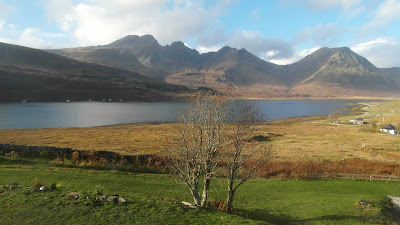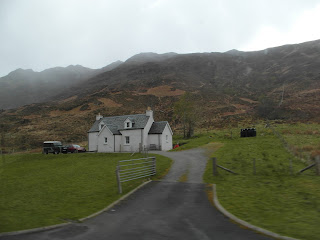'Some days it only rains twice here,' were the words of the Invergarry accountant
cum taxi driver
cum barman, a larger than life Highlander who, in true Lochaber style, knew the occupant of every house from there to Kyle of Lochalsh. And what they had for dinner. Alec MacDonald, a fount of local knowledge, had offered me a lift to the peaceful west coast village of Glenelg, to save a bus journey, and most importantly, to allow me to stop every fifty metres for photos. When you're on a road as spectacular as the road from Invergarry to Glenelg, this requirement is not as absurd as it first seems. I can promise that your camera's memory may be distinctly depleted after this sensational drive, especially if the rain holds off. Not guaranteed in the West Highlands, by any means, but more often than you think, you will get that perfect day, when the autumnal Highland landscapes stand out amid pastel blue skies, with the jagged summits of distant peaks visible at every corner, with the crystal clear lochs reflecting these rich gold hillsides like mirrors. The only trace of cloud in these vast skies is the occasional wisp, which forms a bold St Andrews cross in the deep blue heaven. It is on this day that it seems like the rain has retreated to a far distant planet. It was on this spectacular day that I took in the countless wonders of Scotland's most spectacular road.
The first of the road's wonders is a wide azure loch, hewn into the floor of a mountain-walled glen in the exact form of the map of Scotland. The loch's resemblance to the map of Scotland is surreal, as though it were a creation of Salvador Dali in a painting. Not only is the loch shaped like the map of Scotland, but the landscapes in this awe-inspiring panorama form a Scotland in miniature: a taste of all Scotland's landscapes in one scene. At the foot of the loch, gentle hills sweep down to the shores, depicting the soft pastoral scenes of the Borders. The narrowest point of the loch is spanned by a graceful iron bridge, a hint of the Central Belt's industrial past, the only sign of human civilisation in this unspoilt Highland scene. Beyond, the loch widens out into wilder country, and larch-clad precipices rise high above the water, a piece of Perthshire transmuted into the rugged West Highlands. Then the trees recede, the mountains steepen, and at the loch's head stand the formidable fortress-like summits of the Rough Bounds, a stark, bare, mountainous landscape, so typical of this far north-west corner of Scotland. It is into the heart of these rugged northern landscapes that the road now leads.
 |
| Colourful autumnal vista of the Map of Scotland Loch, Loch Garry |
The road climbs higher into the boulder-strewn desolation, where only the pines withstand the ravages of the Highland weather. As the road twists and turns on its hairpin course, mountains fill every corner of the sky, and the view extends deep into the mysterious interior of remote Lochaber. Over the summit, the fjord-like Loch Loyne cuts a narrow defile into the mountains, watched over by the pyramidal sentinel of Spidean Mialach, one of Lochaber's most shapely Munros, while autumnal larches glow gold along its serene shores.
 |
| The larches glow gold along the serene shores of Loch Loyne, overlooked by majestic rugged mountains in wild Lochaber |
Now descending through switchback after switchback, Lochaber gives way to Inverness, the spruce forests line the road once again, and grand russet mountains overlook a river bubbling over rocks. Presently a twisting road from Inverness and the Great Glen joins on the right. The bustling Highland capital is just forty-two miles away, but it feels like light-years. Now the road hugs the floor of a deep, glaciated valley, and on the left lies the vast Loch Cluanie, a huge body of shimmering blue water, enclosed by mountains that rise to a sheer three thousand five hundred feet, on all sides. The bulk of the great Aonach Meadhoin dominates the view ahead, while the sun beams down on the loch's waters, and the South Glen Shiel ridge opens out on the left, as the road crosses into Lochalsh. The land is ablaze with colour: the granite of the mountain tops have a silver sheen as they rise into sunny skies, the slopes are glistening with autumnal gold, the bracken is illuminated in a dazzling spectrum, and the loch's shores are clothed with deep emerald pines, reflected in the mirror-like water.
 |
| The shores of Loch Cluanie ablaze with colour; Saltire clouds in Highland skies. |
Eventually the loch reaches its head in a deep, glacial valley, the wild Glen Shiel, hemmed in by precipitous mountains, which all have their own distinctive character. The castellated ridge of Druim Shionnach gives way to the sabre-toothed summit of Aonach Air Chrith, whose steep rugged summit looks onto sheer cliffs, which lead to the pointed summit of Maol Chean-dearg.
 |
| The majestic South Glen Shiel ridge, with Aonach Air Chrith (left), Maol Chean-dearg (centre), Sgurr an Doire Leathain (right) |
The next peak along the ridge is the brooding pyramid of Sgurr an Doire Leathain, a truly great mountain, rising above the glen like a spear from its sheath. Now the River Shiel bubbles through the spruce glades, the peaceful home of roaming deer, and above them is the knife-edged ridge of Sgurr an Lochain, a fine peak, dwarfing the forests below.
 |
| The pyramidal peak of Sgurr an Doire Leathain |
The road twists sharply, shoe-horned into the deep glen, walled by the fortress-like mountain ahead Sgurr a Bhealach Dheirg. Here begins the most idyllic section of road in all Scotland. The crystal clear waters of the mirror-like River Shiel tumble down over jagged rocks, the roadside is lined with rich green spruces, and above all this rise two of the Highlands' most awe-inspiring peaks. Sgurr na Sgine, the peak of the knife, lives up to its name as it juts out above the glen like the blade of a dagger, its granite point stabbing at the clear Highland skies. Its neighbour, Sgurr na Forcan, is a giant, sprawling mountain that thrusts its myriad knife-edged peaks into the blue heaven. This is somewhere you could stand forever, as long as the West Highland rain held off, in awe of the majestic landscape.
 |
| The idyllic view of Sgurr na Sgine (left), Sgurr na Forcan (right) and the spruce forests in stunning Glen Shiel |
Only occasionally do gnarled pines and rowans clothe these bare mountain slopes: this is a wild glen, whose wilderness is tamed only by a lonely cottage on the glen floor, I always think of the inhabitant of this house, and the idyllic scenes he must wake up to every morning, jealous of him on a crisp autumn morning. It would be an awesome sight in winter too, when the snow-capped peaks shivered above the glen. I definitely have that house on my list, though I might need some practice digging cars out of snowdrifts before then!
My dream house, Torrlaioghseach in Glen Shiel
The first village in forty miles is at Shiel Bridge, where the road to Glenelg leaves the main road to Kyle of Lochalsh. This is a village dwarfed by the awesome might of the Five Sisters, a mountain range of awe-inspiring height and steepness, the most impressive setting for any Highland settlement. The road twists and turns into a forgotten world, climbing in a series of hairpins over the Mam Ratagan pass, the pass that takes you back in time, to the idyllic Glenelg peninsula, a part of Scotland where time truly stands still. At the top of this pass is the most sensational view over the Five Sisters, seen at their full height, towering over Loch Duich. The houses of Shiel Bridge, and its neighbour Inverinate, are mere dots, set amidst the might of these giants.
 |
| The Five Sisters of Kintail dwarfing the villages at the head of Loch Duich |
As the road begins to descend, it twists westwards into Glen More, and the Cuillins of Skye loom into view, across the blue waters of the Sound of Sleat. The road through the glen is the archetypal scene from old world Scotland. A rough, single-track road with passing places meanders through a deep glacial valley, dotted with the houses of crofts grazed by sheep and Highland cattle, with deer bounding away from the road and friendly Highland figures waving from the roadside, taking a moment's pause from their laborious peat-cutting. In the midst of the pines, where the road meets the sea, and the mountains of Skye rise above the bay, is the sleepy village of Glenelg. If there is anywhere that encapsulates Scottish life in a nutshell, it must surely be this charming West Highland village, where outside a line of whitewashed West Coast cottages, the local ladies walk their westies, the shop advertises Irn Bru and Tunnocks' caramel wafers, and the local inn has roast venison as its special of the day... all looked over by a shimmering blue sea and the rugged mountains of Skye. Can anyone think of a more Scottish scene?
 |
| Picturesque Glenelg at the end of the road. |



















































